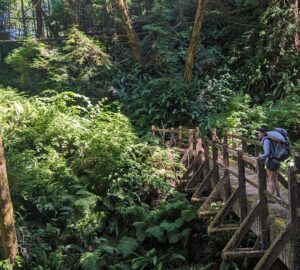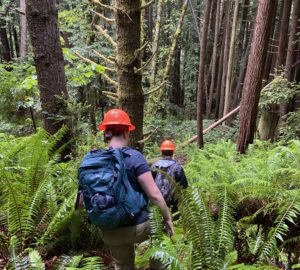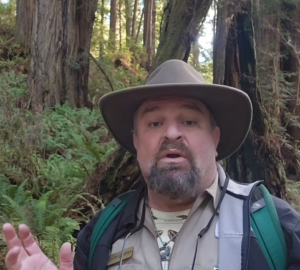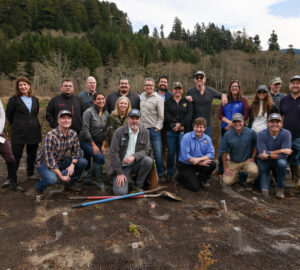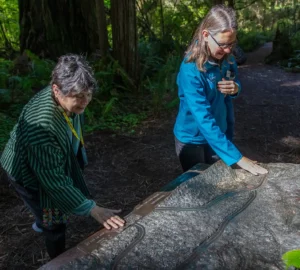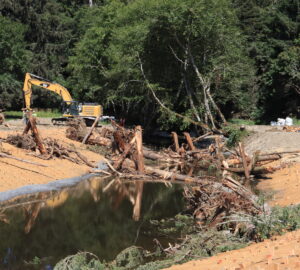REDWOODS magazine: This article was created for our magazine that features redwoods news, breathtaking photos, answers to readers’ questions, stories of how we are realizing our vision for our next century, and how you can help the forest.
The League, members, and partners support a campaign to mitigate the impacts of off-trail hikers in the Grove of Titans, a gem and champion carbon sink.
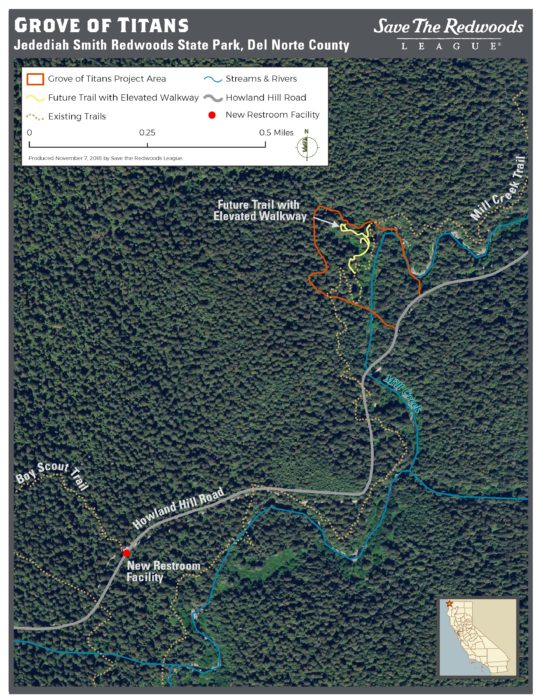
Redwood National and State Parks (RNSP) are the heart of the Northern California coast redwood forests, and in some ways are like a set of Russian nesting dolls. These four parks protect 45 percent of the world’s old-growth redwoods, the tallest living things in existence. Surrounding these expansive wilds of ancient giants are young forests recovering from timber harvests that were conducted before the land was protected.
The parks offer beauty and wildness that has been millions of years in the making, providing an experience of the forest primeval like none other on Earth. Jedediah Smith Redwoods State Park is among the most precious of these incomparable treasures. No roads or trails mark the core of this 10,000-acre forest, which contains 7 percent of the world’s remaining old-growth redwoods. The park is one of the wettest places in the United States, contributing to a forest with more biomass (wood, bark, and leaves) and carbon storage per acre than anywhere on the planet. That biomass, including massive fallen giants of centuries past and ferns that tower overhead, is so dense that it’s almost impenetrable.
Small wonder, then, that a stand of extraordinary redwood giants growing just a short distance from a hiking trail was known only to the indigenous people who have lived in this rugged region for millennia. Then in 1998, a team of research scientists from Humboldt State University stumbled upon the giants and dubbed the area the “Grove of Titans.” In this majestic grove stand some of the world’s largest and oldest coast redwoods. Researchers and RNSP staffers agreed to keep the precise location of the grove secret due to concerns of adverse environmental impacts from excessive and uncontrolled visitation.
OFF-TRAIL VISITORS DAMAGE GROVE
Unfortunately, those worries turned out to be fully justified. Word of the grove spread, inquisitive explorers ultimately determined the location of the Titans, and the grove was soon on the cusp of being loved to death by visitors venturing off of the designated trails. As a result, a tangled network of unofficial “social” trails wending to and around the grove is compacting the soil, exposing the root systems of the ancient monarchs, and tempting hikers to wander unconstrained across the wild and delicate forest floor. Traffic on nearby Howland Hill Road, the main access route to the area, is sometimes gridlocked. Because there are no restrooms near the grove or on nearby roads, the human waste problem has reached crisis proportions, impacting wildlife habitat, undermining the visitor experience, and menacing the water quality in a nearby stream that supports imperiled salmon.
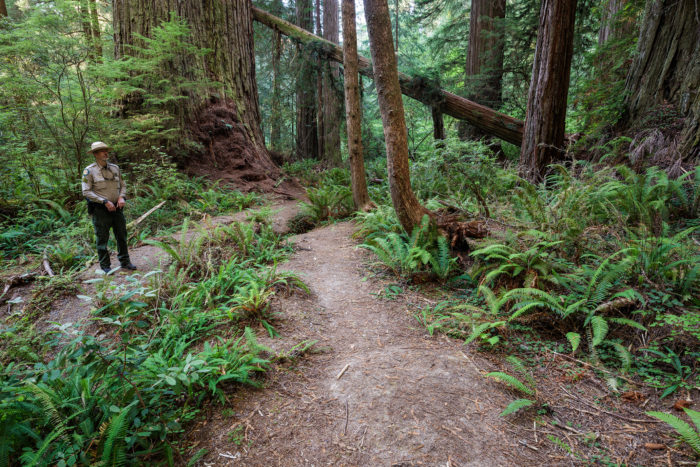
“There were thousands of people visiting, and we were seeing some really serious environmental impacts,” says Victor Bjelajac, the California State Parks Superintendent for the North Coast Redwoods District. “There was also the matter of visitor safety. People can easily become lost or injured when going off established and sanctioned trails.”
In response, Save the Redwoods League, California State Parks, the National Park Service, and Redwood Parks Conservancy have partnered to mitigate the damage and ongoing threats to the Grove of Titans, while allowing for an unforgettable experience in this magnificent grove. Work will begin in the fall of 2019 to remove unsanctioned trails and rehabilitate the damaged habitat and compacted and eroding soil. The project will also include construction of elevated walkways to and around the grove to guide visitors safely without damaging the understory, and installation of restrooms and trash receptacles along Howland Hill Road. In addition, interpretive materials and signage will tell the story of the grove’s restoration, the ecosystem’s sensitivity, and the global importance of this truly special place.
The project got a tremendous boost in the fall of 2018 from Ms. Josie Merck. An artist and conservationist from Connecticut, Josie heard about the urgent need to restore the forest and offered a challenge to match all contributions to the Grove of Titans project dollar-for dollar up to $500,000. Thanks to more than 4,800 passionate League members, Save the Redwoods raised over $837,000 in response to the challenge. Funds raised now total $1.33 million toward the estimated project cost of $3.5 million.
RECORD-HOLDING CARBON STORAGE
The Grove of Titans is noteworthy for more than the awe-inspiring dimensions of its namesake trees. Research by Save the Redwoods League scientists confirms that the redwoods at Jedediah Smith store more carbon than any other forest on the planet. That’s a big deal. At a time when the world is struggling to reduce the proliferation of carbon in the atmosphere, we now know that California’s redwood forest is a powerful tool for capturing atmospheric carbon and mitigating climate change.
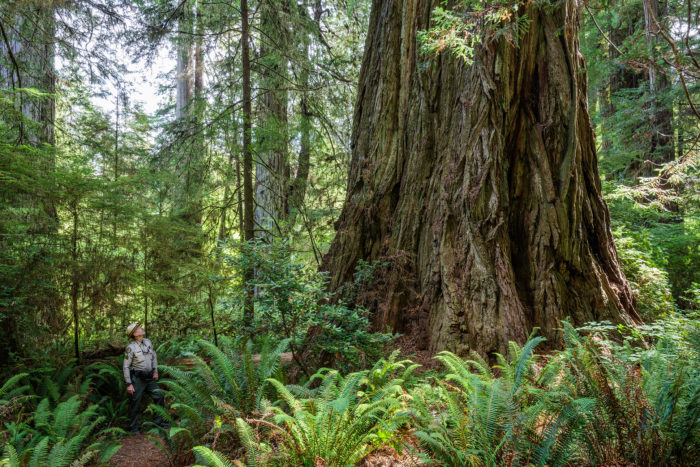
“As part of the Redwoods and Climate Change Initiative (RCCI), the League has established 11 study plots in old-growth forests across the range of the species, and Jedediah Smith definitely holds the record,” said Emily Burns, the League’s former Director of Science. “The RCCI found that old-growth trees in the park — including the Grove of Titans — help the forest store about 1,000 tons of carbon per acre aboveground. Each acre stores an amount of carbon that is roughly equivalent to the annual emissions of 1,700 cars.”
In an era of unprecedented environmental change, when the headlines about our environment are dominated by the deterioration of our natural systems and the loss of biodiversity, the redwood forest offers a story of hope. People have responded with such generosity to the effort to protect and restore the Grove of Titans and other redwood forests because that work represents such a unique opportunity to strive toward a more resilient and sustainable future. We save this forest because it will help to save all of us.

